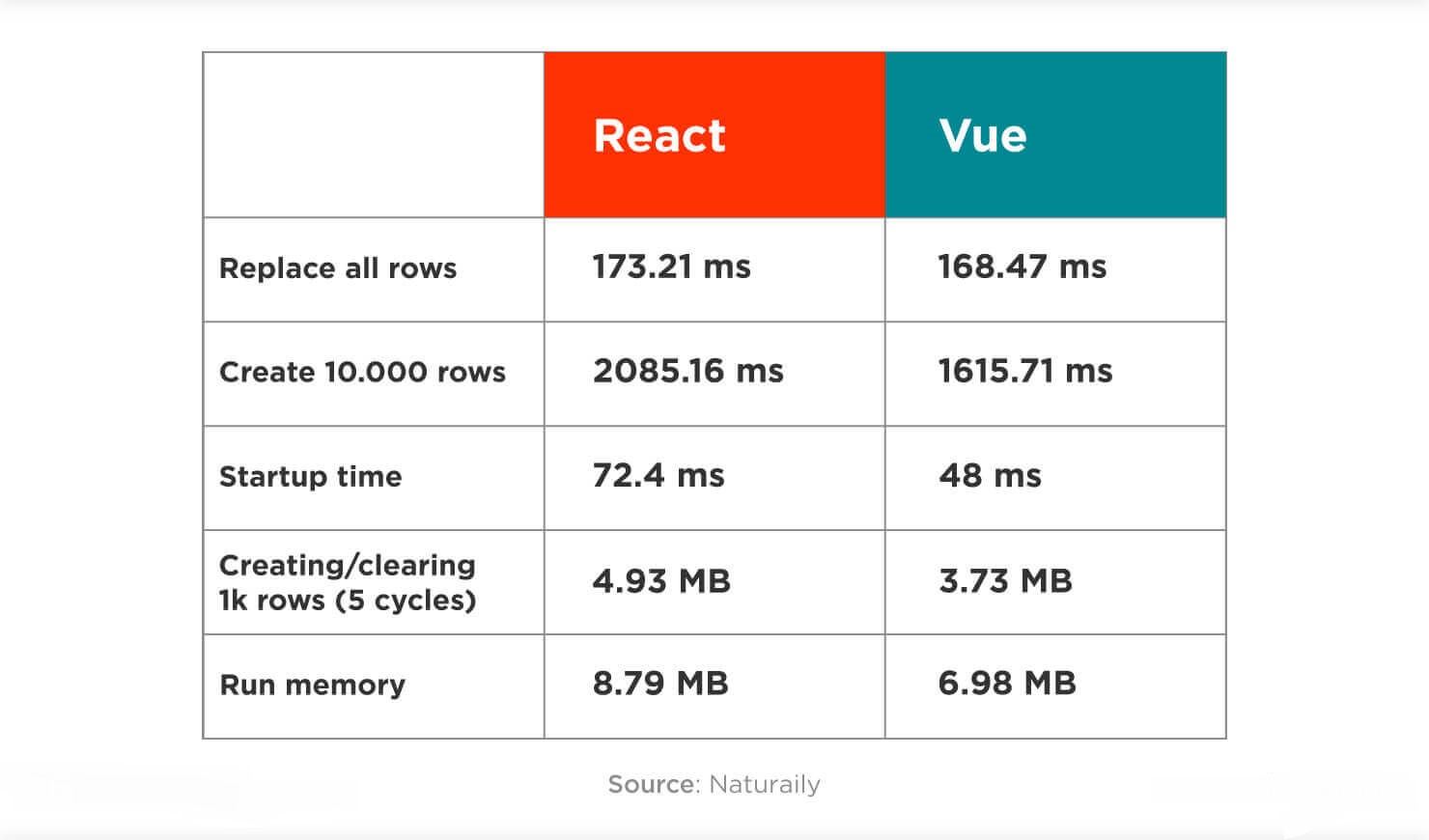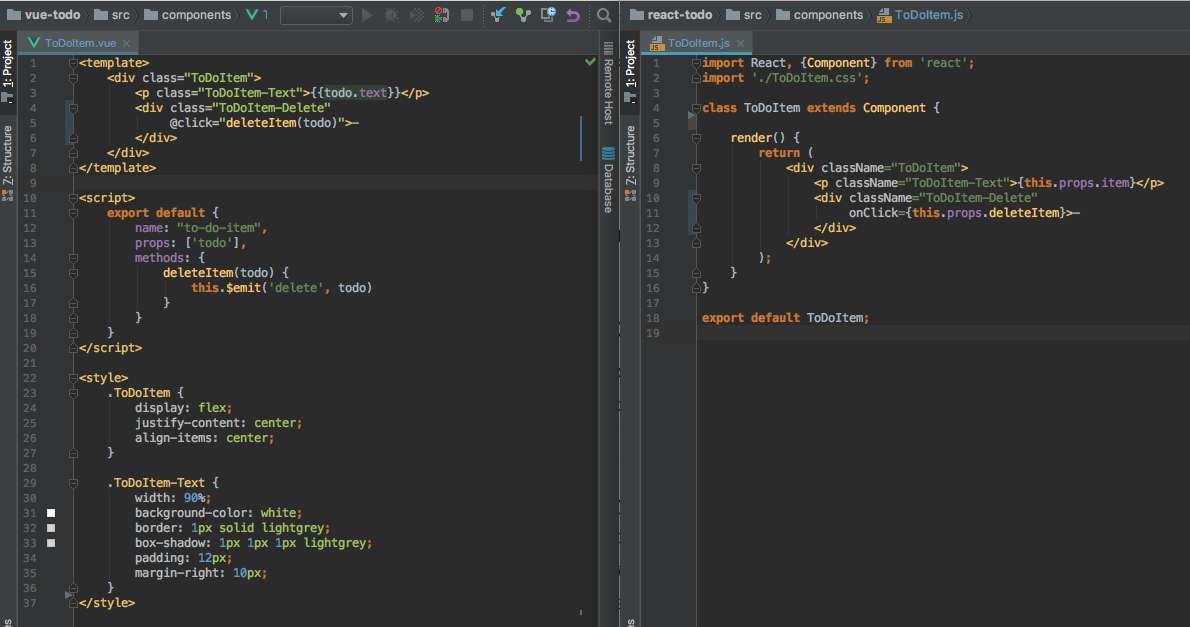JavaScript’s frameworks are critical to developing web projects. However, it can be difficult for companies to choose between React and Vue. It is crucial to understand the Vue vs React differences before committing to one of them. Thus, we recommend evaluating the options to find which bring you more advantages. Spoiler: You don’t have to choose the best one between React and Vue, but the one that best suits your project.

Some struggle to find a difference between Vue and React for a project and determine their benefits. That’s why we prepared this guide to compare Vue and React. It helps you navigate and learn which framework is more useful to apply for technical tasks in front-end development. Additionally, understanding the comparison between React Native and Flutter is essential for developers focusing on mobile app development, as both offer unique advantages for cross-platform projects.
Let’s go over together what you need to learn about Vue vs React performance before choosing between them.
Vue vs React: which is more popular in 2023?
Before we explore the difference between Vue and React and for which purposes it is better to use them, let’s dwell on the causes of their reputation. Both frameworks are prevalent among web developers. Still, the trends of their use have constantly been changing in recent years.
Vue.js and React.js are both external JavaScript frames. Both provide consistent Vue vs React performance and a quality approach to web development. Both Vue and React have their own scripts and meet different business needs.
A team of software engineers from Facebook stands behind React. In turn, Vue was single-handedly developed and distributed by Evan You, a former Google employee, in 2014. Evan intended to use Vue as an open-sourced frontend framework that combined the best frontend development techniques from Angular, Ember, and React with extra tools to create apps more quickly and easily.
The 2022 Developer Survey by Stack Overflow lists Vue.js and React.js among the top 10 most common web technologies used by developers in the market today. However, React is ahead of Vue by four positions. Compared to the same survey from 2021, Vue.js went down one place on the ratings, currently being the 6th most popular JavaScript technology.
JetBrains survey among professional JavaScript developers reports that between 2020 and 2021, the number of Vue users grew from 34% to 43%. So, Vue vs React 2023 debate is still ongoing. However, no solution meets all needs. The usage trends become clearer once you analyze the factors affecting the choice of either technology.

The popularity of the JavaScript framework directly affects the number of developers on the team and the quality of the libraries involved. The framework saves time because someone has already encountered the same scenarios as part of their product development.
The React framework has a massive association of users. It has led to the fact that you can find a lot of guides, online courses, articles, and forums on all things React-related on the internet. Such a large community also speaks volumes about the organized system of third-party libraries, instruments, and additions.
Among other things, this library has support from Facebook, which guarantees developers good support. Each of the FB teams can augment and update the library, using it for several internal projects.
The framework’s competitor Vue has a smaller community so far but is growing steadily. There are also fewer third-party libraries and resources. Moreover, many materials still need a translation from Chinese into English. This problem is gradually getting solved over time, though.
Still, there are many arguments for why Vue is better than React for specific projects. In contrast to React, Vue has more tools. All the major IDEs provide support for Vue, and you can also see its high-level roadmap on GitHub.
Below you can find a more detailed overview that will help you compare Vue and React given your company’s structure, capabilities, and project needs.
Vue vs. React Performance
Let’s now look at the Vue vs. React performance. Remember that Vue and React have some common components and often show similar results in performance tests.
Both frameworks use lazy loading to avoid wasting resources loading unnecessary content. It also allows the site to speed up. If we talk about speed, then startup time slightly beats Vue. At the same time, in terms of script execution time, React wins. Both libraries have packages that speed up uploading the project.
- Vue can handle ten frames per second, while React can only handle one frame per second
- React vs Vue performance libraries use the DOM. Given that changing the real DOM model is a complex task, script updates are primarily used on the virtual DOM model
- In React, changing the state of elements will entail additional rendering. That usually has a significantly bad effect on project performance. Meanwhile, Vue monitors dependencies and prevents child elements from being re-rendered
We can assume that Vue shows slightly better performance results. Nevertheless, here we insist that the speed of running and loading your app depends on the libraries and some other factors.
Overall, Vue may offer higher performance speed and scale your projects. However, React. js has a better ecosystem, many templates, and extra tools. This is why teams on smaller projects often opt for Vue, because speed is a decisive factor, whereas React fits complex web platforms better.

React vs Vue— Application Architecture
When you need to make the code in the project flexible and convenient, dividing the architecture into several layers comes to the rescue.
React is different in that we draw all interface elements through the so-called render functions. The unusual code, a mixture of JS and HTML is where it all happens.
The Vue teams often advise not to choose between templates and render functions, but to combine them: implement the logical part of the code through render functions, and the presentation part using templates. The templates are a simpler alternative, although Vue also has render functions and even support for JSX (React syntax). Some like Vue templates, some like JSX render functions, and both sides claim their code is more readable, but it’s ultimately a matter of personal preference.
In React, you can start a new project from a template, as if getting a blank. But it can’t be customized, and by default there is only one template for a Single Page Application. The Vue project generator provides you with the templates for different applications and build systems, and moreover, the settings of a new project can be saved to a preset and used later. And most importantly: a new project architecture can be configured right in the process of its creation.
Syntax Difference Between Vue and React
React or Vue? If you’ve been wondering what the most significant contrast between Vue.js vs React.js is, then you’ve finally got to this point. It’s syntax.
React stands out, if not for its philosophy, then for its syntax. This is how we would write the headline “Hello world!” in it:
ReactDOM.render(
<h1>Hello world!</h1>,
document.getElementById(‘root’)
);
This unusual mixture of JavaScript and HTML is called JSX. Usually we separate the page layout and the logic of its work, but here we do everything in one file. This code is then converted to regular JavaScript.
Unless other instructions are given, the Vue framework will apply HTML templates. Keep in mind, however, that there is an option to write in JSX.
React provides only JSX. Vue’s separation of HTML, CSS, and JS scripts gives those new to web development experience in creating web applications. HTML templates, among other things, are used by many designers. That allows for a common language and greatly improves communication between design and development teams working on the same project.
Vue vs React syntax is one of determining factors when choosing one of the technologies. The way the view layer is built is a major difference between Vue and React. In React, there’s solely JSX. Whereas, by default, Vue uses HTML templates, but there’s an option to write in JSX, as well.

Hiring Demand and Talent Availability
Although Vue is easier for beginner developers to learn, it’s harder to hire a Vue js developer than a React specialist for your project. That’s why if your company needs to use more sophisticated technology to create a solution, it’s worth hiring a React developer. First, they will understand your project faster. And secondly, it will take much less time to find such a specialist.

The popularity of React suggests that the community includes many experienced developers. According to a Front-End Tooling survey, almost half of developers feel comfortable using React, while only 23% said they could use Vue at a confident level.
Despite this, Vue’s popularity is still gaining force. The framework ranked fourth on the list of technologies developers wanted to explore in 2020. The Software House report on React vs Vue popularity 2022 says that more developers are planning to learn Vue next year than React.
This fact proposes that 2023 will likely increase the number of programmers who will encounter this technology. An essential role in the growing reputation of Vue, as we said earlier, is also the fact that it is more manageable to study. In fact, anyone familiar with HTML, CSS, and JavaScript can learn Vue.js and apply it immediately. Even novice programmers may provide the results with a few lines of code that they learn within the first hours of study.
Developers Experience about React and Vue
The view of skilled programmers on React and Vue will help you make a good choice and understand the most suitable choice for the project. So now we’ll take a look at what programmers like about each technology.
Developers note that Vue.js is attractive because it is easier and faster to learn this library. In addition, programmers can use software templates, and thanks to the extensive documentation, you can implement additional features in the functionality of the applications.
At the same time, React allows programmers to use a large ecosystem of cases and several libraries. There are also more options for its use and fewer limitations. In addition, developers noted that the framework’s popularity also plays a major role in the choice of the development technology stack. Also, it is React ranks first by prevalence and universality.
Both technologies have over 200,000 stars on GitHub, making them the most popular JS library choices in this programming community. However, React has had substantially more Node Package Manager (NPM) downloads over the past five years, with 2022 statistics showing that last year Vue had more than 4 times fewer NPMs than React. So, overall, React ranks first by prevalence and universality.
It is worth pointing out, though, that Vue’s popularity has been affected by the release of Vue 3 in 2022. This was a massive task for a community-driven framework. However, the transition from projects already developed in Vue 2 to the newest edition is rather complicated from a technical point of view.
The team believes that Vue 3 addresses many shortcomings of its previous version. Also, expanded documentation and tool extension would attract the new audience from 2023 onwards.
Tools for React and Vue
Frameworks, libraries, testing utilities, code generators, and debugging extensions are examples of tools that make it easier to create applications. Using tools speeds up the development process and results in cleaner and more reliable code.
When choosing a technology Vue.js vs React for your project, consider that Vue is a standalone framework, while developers should use React in conjunction with other libraries. The pre-built and third-party tools available for React and Vue are different. Therefore, it is worth looking into the Vue vs React differences regarding the tools used.
React uses external solutions (Flux / Redux) for routing and state management. By offering one option to change the script, these frameworks make debugging the load easier. Facebook provides the ability to use response-redux and response-router in management. It leads to a more fragmented ecosystem.
Virtual DOM manipulation, component state management, and competent architecture are all tools programmers use with React. For instance, Facebook has made a Chrome plugin available for debugging React apps. This speeds up and simplifies the debugging process for React web apps. Also, community members create and maintain many additional features for React. This strategy gives developers greater flexibility. However, new developers could struggle with the wide choice of third-party tools.
As for Vue, the core team mainly creates and maintains Vue tools, although community contributions are also frequent. For instance, Vue provides a fantastic panel that integrates with the Browser Developer Tools and enables developers to analyze and interact with the application. Compared to React, Vue offers a more well-rounded selection of third-party and pre-built tools that meet the demands of both seasoned programmers and novices.
Key Differences Between Vue and React
There are significant differences among frameworks, despite their similarities. This diversity affects what kind of project each is proper for.
The difference between React and Vue is in the methods used to render content in the DOM. Vue uses HTML and JSX templates, while React uses only JSX. While JSX is designed to speed up and greatly simplify complex tasks, it can also greatly complicate what was originally intended to be a simple task.
The main solutions of React technology are elements, DOM management, and script management. The rest of the tasks have been developed and continue to be created by the community. Experienced programmers have already become accustomed to this format of work. Nevertheless, novice developers get confused and have trouble using so many third-party libraries and resources.
The framework has Vue, a fairly wide range of quality solutions created by a small community. The core team also develops and continues to support the tools and libraries used. This symbiosis yields a good result that meets the expectations of beginners and experienced professionals alike.
Over time, the difference in approaches between different frameworks began to blur: now companies choose development tools based on their experience and project requirements, and not on their philosophy. Still, frameworks do not compete with each other in efficiency: each has its own context for use.

Let’s begin with the most obvious distinction that form the key difference: React is a library, whereas Vue is a framework. React allows component architecture, DOM manipulation, and state management (the component-level state, not Redux). All the rest gets left up to the community. This approach offers a lot of freedom for the developers.
Will Vue Replace React?
Presently, it’s too early to talk about what can fully replace React. A large community of users and many projects using this framework indicate that a worthy replacement will not come soon.
Is Vue better than React? Despite all the benefits and ease of use of the Vue framework, it is still not so popular. It is a new technology that still needs a lot of time to grow. We can only speculate if Vue will ever become that popular and widespread.
However, as mentioned above, Vue 3 has great potential since it fixes many of the previous version’s problems. As a result, the Node Package Manager (NPM) use of Vue 3 increased by about 200% in 2022.
Vue developers believe many companies would prefer Vue 3 for new projects that they start this year, while websites and applications using Vue 2 will still need maintenance without migrating to the updated version.
As for React’s future, it has solid backing from many companies, including Meta itself. It means that React has a high chance of remaining a stable option for developers in the future.
What is Easier to Learn?
React will still be the leading framework to learn in 2023. But consider that Vue is gaining momentum and popularity because it’s easier to learn and get started.
Despite a large community of developers, React’s documentation is flawed in many ways, so you might think this framework would be very difficult to learn. That is partly true. Nevertheless, the demand for this technology is why more creators are working with it.
On the other hand, the supporting documentation for Vue is written and aimed to be more developer-friendly than the competition. If you have a basic knowledge of HTML and don’t have much development experience, we recommend starting with Vue.
So, these frameworks are similar in learning, but Vue is easier because it supports HTML and JSX.
Documentation Difference
Vue has more advantages over its competitor when it comes to documentation. The official Vue website has been designed amazingly. Here you will find detailed technology descriptions, and the documentation and API links are considered the best. There are clear answers to popular questions.
Nevertheless, as we said below, Vue’s association is still smaller than the number of React users. Therefore, you may have difficulty with out-of-the-box problems.
React documentation is not as perfect. Therefore, programmers are usually more likely to seek help from the community to solve non-standard and complex issues. The incomplete documentation is compensated by numerous additional elements and an enormous association of customers. Accordingly, as far as documentation is concerned, frameworks are generally on the same level.
What is More Secure?
Well, on the security question, you must remember that this depends on the app improvement approach. Not the interface technology.
There were several vulnerabilities in JS. And even very common elements can cause nasty side effects that will carry security risks. That is correct for the two structures. Security in React is more of a concern. Attacks on apps can only happen if you apply one of these vulnerable modules. It includes react-dom in its server-side implementation.
Vue.js is released under the MIT license. It is safe for commercial use. Moreover, Vue programmers can clean HTML code or turn to extra libraries to avoid attacks, even if automated protections against Cross-Site Scripting (XSS) concerns are not present.
Development Cost
Officially, Vue.js developers on Upwork may cost up to $19–$35/hr. Hiring in-house Vue developers may depend on a bunch of common cost factors to budget your organization hiring on the world’s work marketplace. Averagely, the costs may reach $ 47.27 hourly and $ 7563.2 monthly, as per YouTeam rates. Here’s also what they say: average cost of VueJS development (USD) ; $ 30 Min ; $ 48 Mediana ; $ 150 Max.
If we speak about React, in general,the cost of react native mobile apps may range from $15,000 to $300,000, so, the hourly rates of developers salaries on Upwork may vary from $15 to $150 an hour, while fixed price contracts may vary widely, mostly based on the duration or scope of your project or other specifications.
Vue vs. React: Which to Choose for Your Product?
Vue or React? To begin with, React, unlike Vue, provides huge freedom to the developer. Thanks to this, frameworks are available to developers and are available in every way that React applications will be released. React applications can be made fast, performant, and easy to test. Unfortunately, achieving this is extremely difficult, and because of this, many companies may not have high-performance applications. As a result, they become rather overloaded with redundant code and difficult-to-test applications. It is often difficult for novice developers to understand how to write applications correctly.
React is like a bad swimming coach, throwing you in the water and talking about swimming, it doesn’t care if you breathe properly or wave your arms, it cares that you swim and that’s all. By projecting this example onto React, we are able to write very bad working code. This is especially typical in teams where there are no React specialists. People develop and each time they take, they make application harder and harder. Mind that while picking the right thing for your project.
Vue.js is lightweight and emphasizes clean design. Its command-line interface streamlined the development process. The framework performs several tasks automatically and provides several pre-configured settings. Furthermore, the HTML and JS applications provide Vue with an entirely new level of flexibility. It’s a compact solution that also supports data binding and animation.
Vue Pros and Cons
Here you will find some distinct pros and cons of Vue.js which may be a good but unexpectedly controversial as well as bad framework.
Pros
Reactivity is a pro. Data binding is a great thing in the world of interfaces. Instead of micromanaging the DOM as you might do with jQuery, now you can focus on the data. Vue handles them neatly with a two-way reactive data binding system. To achieve this reactivity, Vue adds a few getters and setters to each variable in the state so that it can track changes and automatically update the DOM (this.setState()). However, even this approach is not perfect.
With Vue, we don’t need to resort to unofficial packages like MobX or React Router for critical parts of the application. Vue provides Vue Router and Vuex, a Redux-like reactive state management tool. These are great libraries in their own right, but the fact that they were specifically designed for Vue makes them even better.
Vue is very fast. It may not be the fastest, but its performance is more than enough for the vast majority of web projects.
Whatever your preference, HTML templates have been proven over decades of use in many languages and are the go-to choice for writing dynamic markup in Vue.
But hey, Vue supports JSX, as well. Other benefits:
- Separate file components with HTML, CSS and JavaScript.
- Light. About 20 KB (minimized + gzip).
- Well extensible (mixins, plugins, etc.).
- Excellent documentation.
- Can be adopted gradually, even used as a replacement for jQuery.
- Easy to start using.
Cons
Why is Vue better than React? The transition from React to Vue feels like a breath of fresh air. There is no longer binding (this) or setState(). Hooray! But after a while, you will start to question the correct syntax of Vue components. Vue components are created with objects. Pretty much everything in Vue has its own custom syntax with lots of templates.
If you require a non-reactive state in a component instance, you are entering uncharted territory. It may also have fuzzy architectural patterns when you deal with API.
Vue certainly does what it’s designed to do and excels in areas where others fail, but today companies don’t think Vue is objectively better or worse than other possible options. It just has to fit your project needs perfectly.
React Pros and Cons
Is Vue better than React? Or vice versa? Now let’s have a look at the pros and cons of React.js:
Pros
When working with React, reusable components are found: most often, a UI component can be used in other code variants or even in different projects with little to no changes. Moreover, developers of React applications have been replaced with ready-made component libraries using source code.
React is a JavaScript library for building user interfaces. Please note that this is a library, not a framework. React is often referred to as a framework, but this is a mistake. Firstly, its use does not oblige you to anything, it does not form the “frame” of the project. React detects the state change and updates the appearance of the interface.
Other advantages of React include frequent updates and almost seamless migration from older to newer versions.
Cons
Despite its wide use and popularity in the developer’s community, React still has flaws that often give the green light to other JS frameworks. Here are some of the challenges that programmers face:
- Poor Documentation. ReactJS is a relatively new technology and continues to evolve, with developers contributing to it and expanding its capabilities.
- Confusing JSX syntax.
- The complexity of search engine optimization.
- Again, focus on the user interface.
Vue and React Apps Examples
The proof of React’s, as well as Vue’s popularity, is best shown by the applications that use these technologies today. You may easily find a list of some of the most famous applications based on them for good. Both React and Vue have become very popular with developers, and there are tons of resources that go into much of their technical strengths – such as NodeJS and a host of other related JavaScript frameworks/tools with React. Or customizable and incrementally adoptable Vue projects. At the same time, React is suitable for almost any project, but since the library was originally created for Facebook, it will show itself in all its glory in social network applications: Pinterest and Instagram work on React too.
Facebook initially uses ReactJS, albeit partially. The mobile app is also built on a version of React called React Native, essentially the same, albeit responsible for rendering iOS and Android native components instead of DOM elements. Interestingly, Facebook is where the ReactJS library was initially created, so it’s obvious that it uses it. But even one of the software development team members at Facebook officially verified that some of Facebook’s News Feed uses Vue.js.
Yahoo! Mail
Surprisingly or not, the Yahoo! email client also used React. Ever since Facebook took over Yahoo!, the idea of a powerful and streamlined architecture has been around, which is why React has been included to the maximum. Engineers working on the Yahoo Mail platform needed a lot of updates.
Tesla App
Tesla, the world-famous electric car manufacturer, also used React Native to develop a mobile app. The look and feel of the iOS and Android versions were no different for the end user. All the functionality of the application, including charging, headlights, horn, and panoramic roof, works the same on both platforms.
Xiaomi
The fact that Xiaomi adopts Vue.js in some way, is not clear how. But there is lots of evidence that “Chinese unicorns”, as the creator of Vue.js Evan You once put it, tend to favor Vue.js for some reason.
Netflix
Netflix is the worldwide known go-to streaming service for all the users who are looking to binge-watch great series or watch a film outside of cinemas. Some Netflix internal parts are said to be powered by Vue.js apps, especially some pretty important cloud data storage utilities. Netflix’s developers were happy enough about using Vue.js, then thanks to them Vue.js must be really worth the hype. The React version works with Netflix too, specifically on the Netflix platform called Gibbon. the one which is used for low-performance TV devices instead of the DOM used in web browsers.
Some other big-name companies and brands using React.js to develop their digital products are Instagram, YouTube, TikTok, Khan Academy, Asana, Pinterest, Airbnb, Reddit, BBC, UberEats, Slack, Discord, and Spotify.
Any framework is universal, but Vue is especially good for creating online stores: it is used by Nintendo, Louis Vuitton, BMW USA and Alibaba.
Conclusion
As you can see, each framework has more appropriate use cases and the difference between React and Vue are obvious. None of them is inferior to the other. Nevertheless, accepting the wrong library for your plan may not achieve what you wanted to achieve, so hiring a React.js consultant or a Vue expert might not be a bad idea.
The main thing in managing this tech is to make the right choice. For it, you need to understand well some goals of the web app and companies’ demands. Based on that knowledge, just get the right choice between Vue vs React, plus settle on one of the options which will help develop a good and productive product.
Test both options for design in 2022. Consult with the design and technology team. A lot of factors can ultimately affect your final choice, so don’t be in a hurry. Read the documentation carefully and determine whether you need Vue.js or React Native app development services to create a good product.
If you need help developing an app with Vue.js or React.js, just contact us at Fireart Studio, and we’ll discuss how we can implement your project.





















